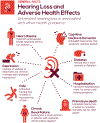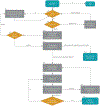Age-Related Hearing Loss: Evidence-Based Strategies for Early Detection and Management
- PMID: 40453791
- PMCID: PMC12123699
Age-Related Hearing Loss: Evidence-Based Strategies for Early Detection and Management
Abstract
Age-related hearing loss (ARHL) is common in older adults and has been linked to significant health and social challenges. These challenges include cognitive decline, depression, falls, and overall decreased quality of life. Despite its high prevalence, ARHL remains underdiagnosed and undertreated, partly due to its gradual onset, stigma, and lack of standardized screening and management protocols. This article provides a comprehensive overview of evidence-based strategies for the early detection and management of ARHL, with an emphasis on recent clinical practice guidelines where nurses are instrumental in leading quality improvement efforts. The multifactorial etiology of ARHL, encompassing genetic predispositions, environmental exposures, and physiological aging, is discussed alongside the health and socioeconomic impacts of untreated hearing loss, including cognitive decline and increased healthcare utilization. Routine screening and hearing assessments can be integrated into patient care visits for individuals aged 50 and above to improve early detection and opportunities for hearing loss management. Effective patient education involves individualized, culturally sensitive counseling that addresses the implications of untreated hearing loss and the benefits of early intervention, which can mitigate stigma and encourage proactive management. Assistive technologies such as consumer devices, hearing aids, and cochlear implants play a vital role in promoting hearing health in personalized care plans developed in collaboration with audiologists. Regular monitoring and follow-up are essential to assess adherence, address challenges, and adjust interventions. By adopting these evidence-based strategies, healthcare professionals can improve identification and management of age-related hearing loss, enhancing the overall health and quality of life for the aging population.
Keywords: HHIE-S; advocacy; age-related hearing loss; artificial intelligence; assistive listening devices; audiology; audiometry; clinical practice guidelines; cochlear implant; cognitive decline; consumer technology; early detection; evidence-based practices; geriatric; health disparities; hearing aids; hearing health; hearing impairment; hearing loss; nurse; nursing; patient education; presbycusis; preventive care; public health; quality of life; screening; sensorineural hearing loss; stigma hearing handicap inventory for screening elderly.
Conflict of interest statement
Conflicts of Interest: None
Figures


References
-
- Adams ET, Nyblade L, Madson G, Wallhagen M, Smith SL, Stelmach RD, & Francis HW (2024). Development and Preliminary Validation of Scales to Measure Enacted, Perceived, and Experienced Hearing Loss Stigma in Health Care Settings. Ear and Hearing, 45(Suppl 1), 42S–52S. 10.1097/AUD.0000000000001541 - DOI - PubMed
-
- Age-Related Hearing Loss (Presbycusis). (2023, March 17). https://www.nidcd.nih.gov/health/age-related-hearing-loss
-
- Arnold ML, Hyer K, Small BJ, Chisolm T, Saunders GH, McEvoy CL, Lee DJ, Dhar S, & Bainbridge KE (2019). Hearing Aid Prevalence and Factors Related to Use Among Older Adults From the Hispanic Community Health Study/Study of Latinos. JAMA Otolaryngology--Head & Neck Surgery, 145(6), 501–508. 10.1001/jamaoto.2019.0433 - DOI - PMC - PubMed
-
- Bennett RJ, Saulsman L, Eikelboom RH, & Olaithe M (2022). Coping with the social challenges and emotional distress associated with hearing loss: A qualitative investigation using Leventhal’s self-regulation theory. International Journal of Audiology, 61(5), 353–364. 10.1080/14992027.2021.1933620 - DOI - PubMed
Grants and funding
LinkOut - more resources
Full Text Sources
